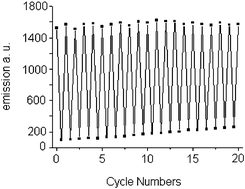Modulation of a fluorescent switch based on a controllable photochromic diarylethene shutter
Abstract
A convenient system of modulation of a fluorescent switch based on photoisomerization of diarylethene has been demonstrated by employing 9,10-anthracenedinaphthalene 1 and benzothiazole diarylethene 2a as the fluorescence


 Please wait while we load your content...
Please wait while we load your content...